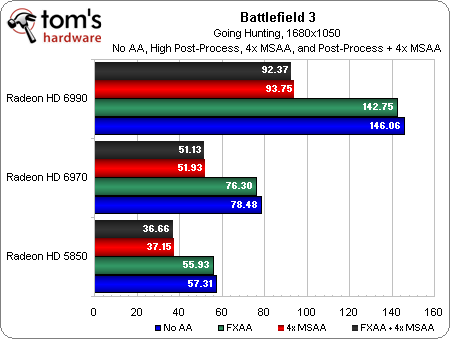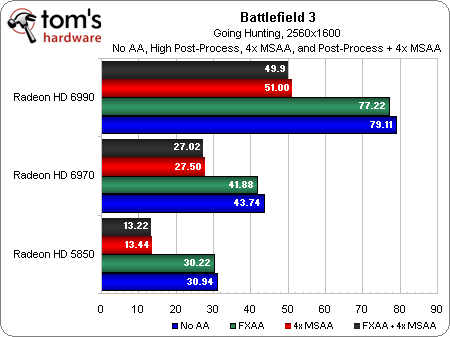Battlefield 3 Performance: 30+ Graphics Cards, Benchmarked
Are you wondering how your PC will handle Battlefield 3 before buying the game? We pulled a series of all-nighters to get almost every graphics card in our lab tested, in addition to a handful of processors, to answer your performance-oriented questions.
Benchmark Results: AMD Graphics Cards, Post-Process And MSAA
In AMD’s Battlefield 3 documentation, the company makes a big deal about the difference between the Anti-Aliasing Post and Anti-Aliasing Deferred options, which toggle on and off Fast Approximate Anti-Aliasing and Multi-Sample Anti-Aliasing, respectively. Both features do different things, but have very disparate effects on performance.
It’s easy to see why AMD is so concerned with the use of Anti-Aliasing Deferred: it imparts a massive frame rate drop, which takes a card like the Radeon HD 6970 that might be playable at 2560x1600, or a Radeon HD 5850 at 1920x1080, and beats performance back quite a bit. Anti-Aliasing Post, on the other hand, though not always an effective approach, barely touches speed.
Perhaps more worrying for AMD is that, while the GeForce cards are also hit pretty hard by MSAA, the impact is far less detrimental. At no point does the addition of 4x MSAA take an Nvidia board from playable to unplayable (aside from maybe the GeForce GTX 285 at 1680x1050). AMD can’t say the same.
You’re at least safe turning Anti-Aliasing Post to High on AMD’s cards. Whether you want to mess with MSAA depends on how much performance you have “in reserve” to throw at eye candy.
Get Tom's Hardware's best news and in-depth reviews, straight to your inbox.
Current page: Benchmark Results: AMD Graphics Cards, Post-Process And MSAA
Prev Page Benchmark Results: AMD Graphics Cards, Low Quality Next Page Benchmark Results: AMD Graphics Cards, CrossFire-
great review. but I am curious if a gtx 560ti can run ultra on a playable fps? because I am about to buy one :DReply
-
orellius nevermind my comment about 560 Ti, I see it in the benchmarks (high) but it is not on the main page list of cards (missed putting it there?) (yes, I used the search feature in my browser, no 560 to speak of)Reply -
m0th2 sirus3020great review. but I am curious if a gtx 560ti can run ultra on a playable fps? because I am about to buy oneReply
Without any form of AA you can run it on ultra and get over 30fps on every map @ 1920x1080 easily (over 60 when close quarters). Depends on your cpu and if you OC your gpu though. i have mine at 940/2100 and its always above 40fps. -
kcorp2003 AWESOME! thank you very much for this. looks like i wont have to upgrade my CPU then. i have HD4870 and i play this on medium settings but still i want the ultra settings. :)Reply -
aznshinobi Great read, lovely to see a wide assortment tested, specially my 5850. Thanks for taking the time Chris, I'm sure it must've taken FOREVER to bench and swap all those cards.Reply



